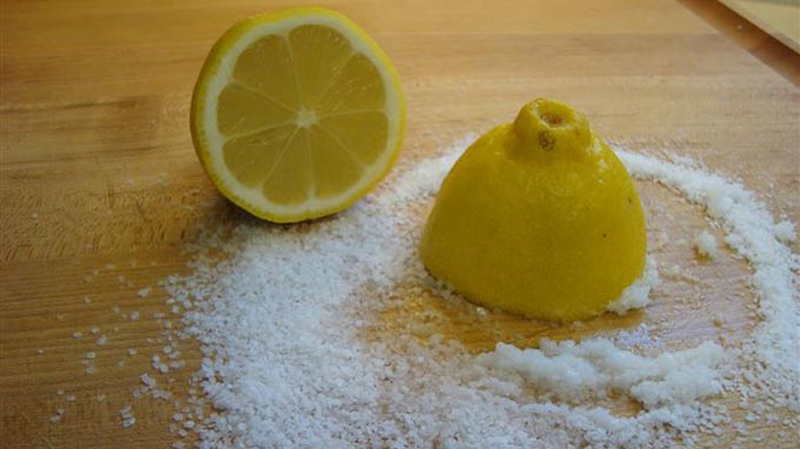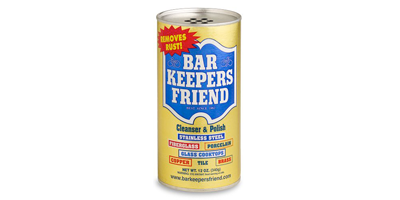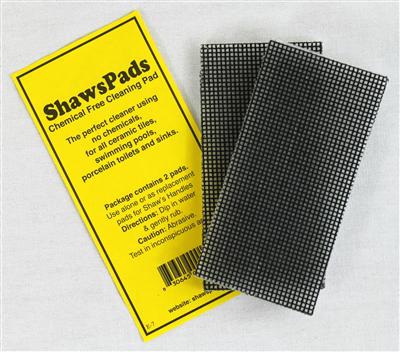Stains like rust can occur from mineral deposits found in hard water especially if the water you are using is well water, which contains high levels of iron. This staining can also come about from galvanized pipes that have rust and are leaking into a sink.
Rust stains are not easy to remove. If you keep getting rust stains and notice that the stain is chronic, you may have to replace that sink. Most rust stains are not as bad, and you can successfully remove them if you know how to go about it. However, powdered cleansers that contain chlorine or regular cleansers for your toilet bowl are not going to get rid of the rust.
How to Remove Rust from Sink
White Vinegar and Baking Soda
Leaving a baking sheet on your sink for too long can leave the sink with rust. To remove the rust, use some white vinegar and baking soda. Slowly add little drops of white vinegar to the baking soda so that it does not explode to your face. Mix them together to form a paste. Pour the paste on the spots that have rust and leave them there for 10 minutes. Next, take a spoon, and using the flat back, gently rub the paste into the rust. Leave it for about 15 minutes then rinse with water and soap. Repeat the process.
Lemon Juice and Salt
On answering how to remove rust from sink, this method is one of the most effective and easiest to perform. Take the lemon juice and pour it on the stain. Leave it on for about ten minutes then take a wash cloth and scrub the stain off. If the stain is still there, take a second dose of the lemon juice and some salt. Pour the lemon juice on the stain and then some salt on it. Leave it for about fifteen minutes. Take an old toothbrush and rub the stain off. At the end of this process, the stain may be completely removed and if not, repeat the process until it has. You may also notice slight discoloration on the area that had the rust stain.
Bar Keepers Friend
Bar Keepers Friends is the non-abrasive powder with a non-bleach formula that is recommended on stainless steel cookware. It cleans kitchen sinks and counter tops and works well on cook-tops, glass and ceramic. It also cleans many other household surfaces - saucepans, grouting, worktops, copper, brass and china. In the bathroom, it cleans shower doors, bathtubs and sinks. You can also use it to clean toilet bowls to avoid harsh chemicals. In the garage, Bar Keepers Friend cleans car wheels, golf clubs, rusty grills and more.
See product description and reviews here.
Shaw’s Pads
These are cleaning pads that are chemical free and used to remove stains from ceramic and porcelain sinks. Some of the stains Shaw’s Pads remove include rust stains along with water, lime and calcium build-up. It can also be used to clean stains found on standing water. If your sink have stains from hard water, these pads will help you get rid of them. They are great for scrubbing stains of all things made of porcelain. They are not only environmentally safe and safe for septic tanks, but are also both easy and gentle to use.
See product description and reviews here.
US Pumice Heavy Duty Scouring Stick
This scouring stick works great by giving good abrasive action. It will do the job where other cleaning aids have failed. It scours away scale, stains, rust and mineral deposits from showers, tubs and sinks. It also easily removes hideous toilet rings, cleans carbon build-up, grease and baked-on grills, iron cookware and ovens. It is also safe to store and use around children. It is safe for sinks. This scouring stick also removes rock-hard deposits of mineral found around drains and faucets. It can also help get rid of unwanted paint on concrete, masonry and tile surfaces.
See product description and reviews here.
Other Methods
White vinegar and Aluminum foil: Simply dip some aluminum foil in some white vinegar and scrub the rust away.
Baking Soda and water: Take some baking soda and pour it on the rust. Take an old toothbrush, apply some water on it then scrub the rust off.
How to Prevent Formation of Rust in Sinks and Bathtubs
Install water softener slat. This can remove the iron in water thus preventing rust stains in your toilet bowls, sinks and bathtubs.
Remove metallic cans from the sink and bathtub. Metal cans like those that contain air fresheners and shaving creams have metal rings at the bottom. These rings rust and end up causing rust stains on surfaces. Instead, store these cans in a cabinet.
After using a sink or tub, wipe it down. That way, you will have removed iron residue and standing water.
Ventilate bathrooms. Ventilation reduces moisture and this in turn decreases the likelihood of water pooling in the sink or tub.
The video below shows more on how to remove rust from sink using rust remover:








View All Comments /Add Comment